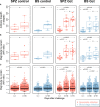The acquisition of humoral immune responses targeting Plasmodium falciparum sexual stages in controlled human malaria infections
- PMID: 35924245
- PMCID: PMC9339717
- DOI: 10.3389/fimmu.2022.930956
The acquisition of humoral immune responses targeting Plasmodium falciparum sexual stages in controlled human malaria infections
Abstract
Individuals infected with P. falciparum develop antibody responses to intra-erythrocytic gametocyte proteins and exported gametocyte proteins present on the surface of infected erythrocytes. However, there is currently limited knowledge on the immunogenicity of gametocyte antigens and the specificity of gametocyte-induced antibody responses. In this study, we assessed antibody responses in participants of two controlled human malaria infection (CHMI) studies by ELISA, multiplexed bead-based antibody assays and protein microarray. By comparing antibody responses in participants with and without gametocyte exposure, we aimed to disentangle the antibody response induced by asexual and sexual stage parasites. We showed that after a single malaria infection, a significant anti-sexual stage humoral response is induced in malaria-naïve individuals, even after exposure to relatively low gametocyte densities (up to ~1,600 gametocytes/mL). In contrast to antibody responses to well-characterised asexual blood stage antigens that were detectable by day 21 after infection, responses to sexual stage antigens (including transmission blocking vaccine candidates Pfs48/45 and Pfs230) were only apparent at 51 days after infection. We found antigens previously associated with early gametocyte or anti-gamete immunity were highly represented among responses linked with gametocyte exposure. Our data provide detailed insights on the induction and kinetics of antibody responses to gametocytes and identify novel antigens that elicit antibody responses exclusively in individuals with gametocyte exposure. Our findings provide target identification for serological assays for surveillance of the malaria infectious reservoir, and support vaccine development by describing the antibody response to leading vaccine antigens after primary infection.
Keywords: Plasmodium falciparum; antibody responses; controlled human malaria infection (CHMI); gametocyte antigens; malaria; sexual stage.
Copyright © 2022 de Jong, Alkema, Oulton, Dumont, Teelen, Nakajima, de Assis, Press, Ngotho, Tetteh, Felgner, Marti, Collins, Drakeley, Bousema and Stone.
Conflict of interest statement
The authors declare that the research was conducted in the absence of any commercial or financial relationships that could be construed as a potential conflict of interest.
Figures




Similar articles
-
Recognition of Plasmodium falciparum mature gametocyte-infected erythrocytes by antibodies of semi-immune adults and malaria-exposed children from Gabon.Malar J. 2017 Apr 26;16(1):176. doi: 10.1186/s12936-017-1827-7. Malar J. 2017. PMID: 28446190 Free PMC article.
-
A randomized feasibility trial comparing four antimalarial drug regimens to induce Plasmodium falciparum gametocytemia in the controlled human malaria infection model.Elife. 2018 Feb 27;7:e31549. doi: 10.7554/eLife.31549. Elife. 2018. PMID: 29482720 Free PMC article. Clinical Trial.
-
Low Levels of Human Antibodies to Gametocyte-Infected Erythrocytes Contrasts the PfEMP1-Dominant Response to Asexual Stages in P. falciparum Malaria.Front Immunol. 2019 Jan 14;9:3126. doi: 10.3389/fimmu.2018.03126. eCollection 2018. Front Immunol. 2019. PMID: 30692996 Free PMC article.
-
Immune Responses to Gametocyte Antigens in a Malaria Endemic Population-The African falciparum Context: A Systematic Review and Meta-Analysis.Front Immunol. 2019 Oct 22;10:2480. doi: 10.3389/fimmu.2019.02480. eCollection 2019. Front Immunol. 2019. PMID: 31695697 Free PMC article.
-
Immunity against sexual stage Plasmodium falciparum and Plasmodium vivax parasites.Immunol Rev. 2020 Jan;293(1):190-215. doi: 10.1111/imr.12828. Epub 2019 Dec 16. Immunol Rev. 2020. PMID: 31840844 Free PMC article. Review.
Cited by
-
Understanding and maximising the community impact of seasonal malaria chemoprevention in Burkina Faso (INDIE-SMC): study protocol for a cluster randomised evaluation trial.BMJ Open. 2024 Mar 12;14(3):e081682. doi: 10.1136/bmjopen-2023-081682. BMJ Open. 2024. PMID: 38479748 Free PMC article.
-
Advances in Microfluidics for Single Red Blood Cell Analysis.Biosensors (Basel). 2023 Jan 9;13(1):117. doi: 10.3390/bios13010117. Biosensors (Basel). 2023. PMID: 36671952 Free PMC article. Review.
-
A potent and durable malaria transmission-blocking vaccine designed from a single-component 60-copy Pfs230D1 nanoparticle.NPJ Vaccines. 2023 Aug 18;8(1):124. doi: 10.1038/s41541-023-00709-8. NPJ Vaccines. 2023. PMID: 37596283 Free PMC article.
-
Target-agnostic identification of human antibodies to Plasmodium falciparum sexual forms reveals cross-stage recognition of glutamate-rich repeats.Elife. 2025 Jan 16;13:RP97865. doi: 10.7554/eLife.97865. Elife. 2025. PMID: 39817720 Free PMC article.
References
Publication types
MeSH terms
Substances
Grants and funding
LinkOut - more resources
Full Text Sources
Medical
Miscellaneous

